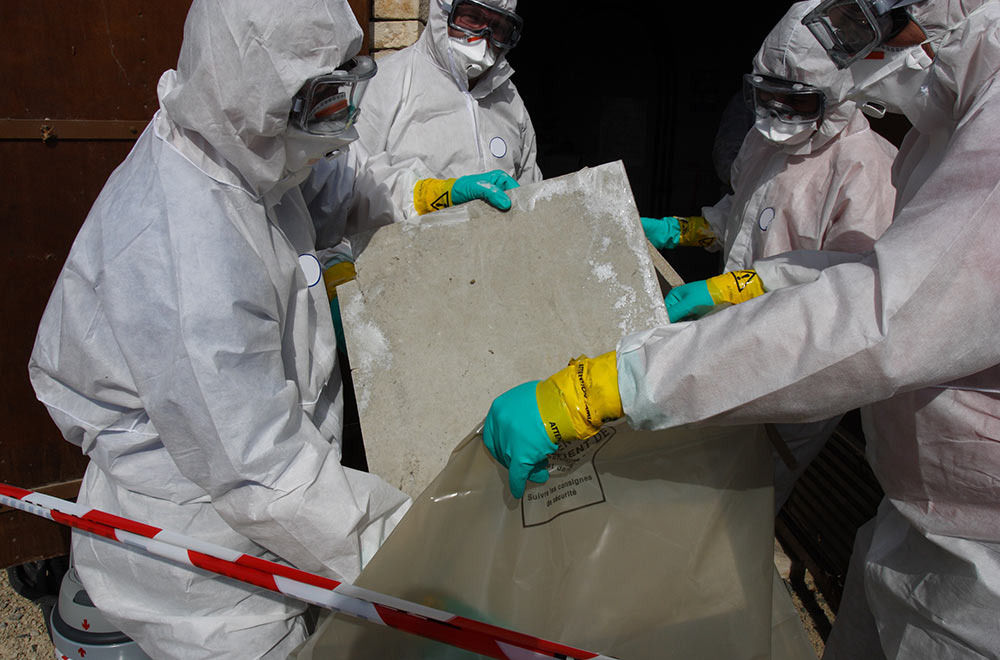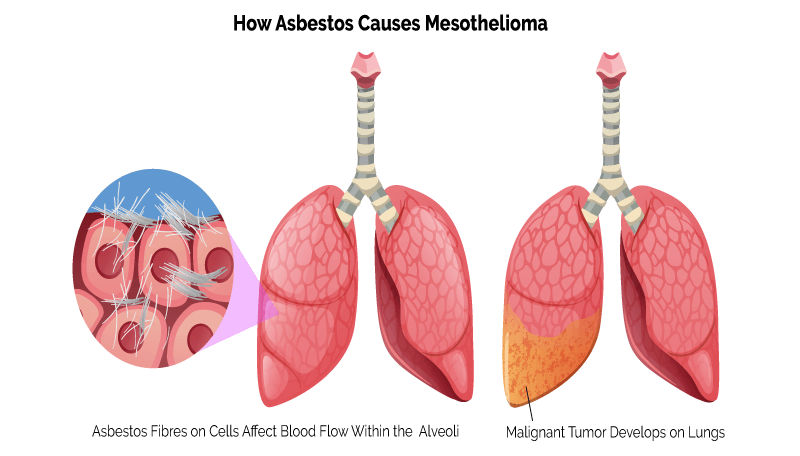Why are many people still making asbestos disease compensation claims in South Wales?
You would be forgiven for thinking that asbestos disease should be a thing of the past. After all the most dangerous kinds of asbestos, amocite (brown asbestos) and crocidolite (blue asbestos) were banned from being imported into this country and used in any form, as long ago as 1985. Then in 1995, white asbestos, otherwise known as chrysotile, was banned as well. In theory, that should have seen discussion about this useful, but deadly mineral, confined to the history books. Sadly, the effects of asbestos disease are very much still with us today.
Asbestos diseases are caused by people being exposed to asbestos fibres. In most cases, this took place in work place settings. When asbestos is sawn, cut or drilled, it throws up clouds of fibres. Anyone working in the immediate area, was at risk of breathing in the fibres. They would not have been able to avoid it. This was because in the days when asbestos was being used in industry workers were rarely, if ever, provided with any form of breathing protection. Even the most basic of masks were not provided, most of the time.
Over time, this constant exposure caused the asbestos fibres to settle on the linings of the affected person’s lungs. Initially, inhaled asbestos does not cause any immediate obvious harm to the person who has breathed it in. However, eventually, after many years of lying dormant within the body, symptoms start to appear.
The period from being exposed to asbestos through to symptoms of asbestos disease appearing, is known as the latency period. This period can last anything between 10 and 50 or more years. The average length of the latency period is approximately 35 years. If a person was exposed to asbestos in their late 30s they may not develop asbestos disease until they are 70 years of age or more.
What are the most common types of asbestos disease?
There are four main types of asbestos disease or illness;
Mesothelioma
This is often just referred to as ‘meso.’ At the present time, there is no known cure for mesothelioma. It is a type of cancer and usually effects the linings of the lungs, although there is also a condition known as peritoneal mesothelioma which affects the stomach. The only known cause of Mesothelioma is exposure to asbestos. It is a fatal illness.
Read our Mesothelioma Claims advice.
Asbestos lung cancer
A cancer like mesothelioma, but one that forms inside the lungs as opposed to mesothelioma which forms in the lining of the lungs. Whereas asbestos exposure is the only known cause of mesothelioma, lung cancer has several potential causes, with smoking being by far the biggest.
Read our Asbestos Lung Cancer Compensation Claims page for more detailed advice.
Asbestosis
People often mistakenly refer to asbestos disease in general, as asbestosis. Asbestosis is in fact just one form of asbestos related illness. It is a scarring of the lungs caused by the asbestos fibres that have become trapped within them. It causes serious shortness of breath, as well as chest pain, wheezing, a persistent cough and fatigue.
You can find out more about asbestosis compensation claims here.
Pleural thickening
Another asbestos related condition, where the asbestos fibres that have become trapped, over time cause scarring of the pleural membrane that lines the lungs and the chest wall. Breathing becomes restricted.
Find out how to make a pleural thickening compensation claim.
What are the symptoms of asbestos disease?
Common symptoms of asbestosis include the following: –
- A persistent cough
- Shortness of breath
- Wheezing
- Fatigue
- Chest pain
You will have noticed that the symptoms listed above are of a general nature i.e. any or all of them are the type of symptoms that could be experienced when suffering from other, often minor ailments. It must be stressed that by having one or more of these symptoms, it does not mean that a person is suffering from an asbestos related illness. However, anyone suffering symptoms like these and who has previously worked with asbestos, even if it was a long time ago, would be advised to see their GP as soon as possible. If nothing else you will be able to rule out the possibility of having developed an asbestos related illness.
What were the high-risk occupations for getting asbestos disease in South Wales?
The jobs where you were most at risk of getting asbestos diseases, were those where asbestos was being worked with, on a regular basis.
Dockworkers
The dockers who worked at the docks of Barry and Vale of Glamorgan were at risk of asbestos disease. Dockers were put into cattle style pens, by the Dock Labour board and then men were chosen to go and unload from ships that had arrived in the docks. Often the dockers work would involve them in unloading bags of blue asbestos which was being imported from countries like South Africa.
Asbestos fibres were everywhere, whilst the unloading was taking place, as bags ripped open and spread the deadly dust all over the place. Like almost all workers who were exposed to asbestos, the dockers were not provided with masks or any kind of protection from the dust.
Power Station Workers
The power stations near to Llanelli and in Carmaerthen were asbestos hotspots. Because power stations are full of heat creating machinery, early versions of these large installations used asbestos on the lining of the stations as a heat resistant material to prevent fires.
This meant that in the normal course of going about their daily business the power station workers of South Wales (and elsewhere) were exposed to asbestos fibres which filled the air all the time.
Steelworkers and Asbestos Disease
South Wales has had its fair share of steelworks over the years – Port Talbot Steelworks, Llanwern Mill, Ebbw Vale steelworks and more. Once again, the heat retardant qualities of asbestos meant that it was in regular use at the baking hot steelworks. Many steelworkers who were exposed to asbestos on a regular basis have already made asbestos disease compensation claims. Sadly because of the long latency period of the disease from exposure to symptoms and diagnosis, former steelworkers are still being diagnosed with asbestos related illnesses.
Coal mining
Although many of the industrial diseases that have blighted the lives of numerous miners from South Wales, were those connected directly to the inhaling of coal dust (pneumoconiosis and silicosis), it was an industry where asbestos exposure was a problem for miners too.
Pit machinery above ground was full of asbestos. So too were the shafts of the lifts that transported the men to and from the coal face. Many miners have avoided the brutal illnesses of silicosis and pneumoconiosis only to succumb to asbestos disease.
Other high at-risk occupations for asbestos disease were;
- Railway engineering
- Construction
- Shipbuilding/Shipyard workers
- Power station workers
- Demolition
- Car mechanics/ Vehicle and coach body repair
- Painters
- Joiners and carpenters
- Shipwrights
- Electrical
If I think I may have asbestos disease what should I do?
If you worked in an industry where you may have been exposed to asbestos and you are now suffering symptoms that you believe may indicate that you have an asbestos disease, you should make an appointment to see your GP. When discussing the symptoms that you have with your doctor, it’s important that you tell them that you worked in an industry where you were exposed to asbestos.
If your doctor thinks that you may be showing signs of an asbestos illness, then you will be referred to a consultant. The consultant is likely to arrange for you to have a CT scan or chest x-ray. That will indicate whether there are signs of asbestos disease showing up on your lungs.
How do I make an asbestos disease compensation claim in south Wales?
If you have been diagnosed with an asbestos related illness or even if you have not yet been diagnosed with one of the asbestos diseases, but are at the stage of suffering from symptoms that may indicate you have one of the asbestos diseases, then contact Mooneerams solicitors. We work in close partnership with a specialist asbestos disease solicitor, who only deals with asbestos compensation cases and who has over 20 years’ experience in this complex and specialised area of law.
The solicitor will call you at your convenience to discuss your work history, advise you in more detail as to what you should discuss with your doctor or consultant and guide you through the whole process. This telephone consultation will be entirely free of charge. If he believes that you have grounds for making an asbestos disease claim, then he will arrange to visit you at home.
The asbestos specialist solicitor, will take your claim on under a No Win, No Fee arrangement and upon a successful conclusion of your claim, he will not charge you a success fee – that means he will not take a percentage of any compensation that you receive. The solicitor will discuss this in more detail with you at the earliest possible stage.
Mooneerams solicitors do not receive a fee for this service from the solicitor, nor do we take any form of fee from you. We want you to receive the same level of care and attention to your asbestos disease claim, that you would get from us, if we were pursuing a personal injury claim for you. We are confident that by entrusting your asbestos compensation claim to our trusted asbestos claim partner, that you will be in very good hands.
What if the company that I worked for when I got exposed to asbestos, is no longer in business?
That is part of the benefit of working with an expert asbestos disease solicitor. Even if the company no longer exists the solicitor will in most cases be able to trace with whom that company was insured and make the appropriate claim against them, on your behalf.
What do I do next?
Contact us here at Mooneerams on 029 2048 3615 or send us a message using the contact form.
With your permission, we will ask the asbestos disease solicitor to contact you, to arrange a telephone consultation with you that will be entirely free of charge. We will only pass your details on to the solicitor, with your express permission.























